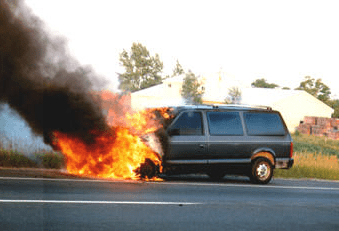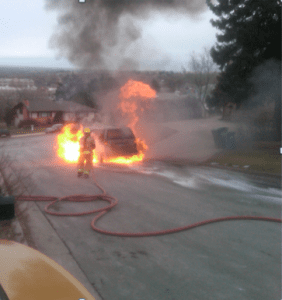 I’d like to thank one of the loyal Situational Awareness Matters readers (whose name and department I am holding in confidence) for sending me a picture and a story about a van fire, no, a ‘routine van fire‘ his department had recently. On the arrival of the engine, the officer reported a working fire and the crew pulled a line and started the attack. Then, something unexpected happened, followed by something very unexpected, followed by something that was nearly tragic.
I’d like to thank one of the loyal Situational Awareness Matters readers (whose name and department I am holding in confidence) for sending me a picture and a story about a van fire, no, a ‘routine van fire‘ his department had recently. On the arrival of the engine, the officer reported a working fire and the crew pulled a line and started the attack. Then, something unexpected happened, followed by something very unexpected, followed by something that was nearly tragic.
This is a picture taken from the scene. Everything looks in order. The firefighter on the attack line is in full PPE. Then… the vehicle starts rolling down the hill. In this picture, the vehicle is careening down the hill with the firefighter on the hose line in pursuit. And, to complicate the situation further, there is a firefighter in the driver’s seat of the van.
How did this happen?
The crew arrived and began fighting the fire. As the vehicle started to slowly drift, one of the firefighters jumped behind the wheel to ensure the vehicle was in park. The van started rolling faster down the hill. The firefighter depressed the brake peddle. The sudden stoppage of the van caused the fire-weakened fuel line to rupture and the vehicle erupted into flames.
The firefighter was able to bail out of the vehicle before it rolled all the way to the bottom of the hill, out of reach of the attack line, and ran into two additional vehicles (one occupied). This kept the burning van from crashing into the house at the bottom of the hill.
The firefighter suffered significant burns on his face and neck because he was not wearing his Nomex hood. It was reported to me that this firefighter was in the habit of routinely not wearing his Nomex hood while fighting vehicle fires. (It has also been reported that this incident has changed his outlook on that practice.)
The writer shared the following lessons with me:
- Nomex hoods 100% of the time.
- Chock the wheels at vehicle fires.
- Park the fire apparatus uphill and past the burning vehicle.
SOLUTION
Avoid falling into the trap of complacent practices that may compromise safety simply because it’s something that’s been done over and over again without a consequence. There is no such thing as a routine fire of any kind. Unexpected things happen and conditions can become bad quickly. Wear full protective gear. When you critique incidents, play a ‘what if’ game and talk through some uncommon scenarios that could have happened and how they might be handled.
DISCUSSION QUESTIONS
1. Do you always wear your full protective ensemble for vehicle fires?
2. Do you always chock the wheels of a vehicle on fire?
3. During incident critiques, do you routinely discuss the realistic ‘what if’ scenarios that did not occur (but could have) and the best way to handle it?
_____________________________________________________

If you are interested in taking your understanding of situational awareness and high-risk decision making to a higher level, check out the Situational Awareness Matters Online Academy.
CLICK HERE for details, enrollment options and pricing.
__________________________________
Share your comments on this article in the “Leave a Reply” box below. If you want to send me incident pictures, videos or have an idea you’d like me to research and write about, contact me. I really enjoy getting feedback and supportive messages from fellow first responders. It gives me the energy to work harder for you.
Thanks,

Email: Support@RichGasaway.com
Phone: 612-548-4424
SAMatters Online Academy
Facebook Fan Page: www.facebook.com/SAMatters
Twitter: @SAMatters
LinkedIn: Rich Gasaway
Instagram: sa_matters
YouTube: SAMattersTV
iTunes: SAMatters Radio
iHeart Radio: SAMatters Radio

